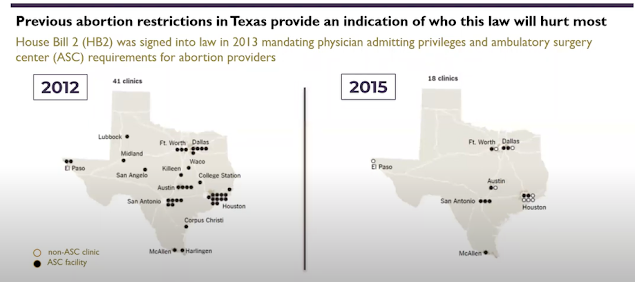Many thanks to Dr. Robin Wallace for a really poignant and timely Grand Rounds this week on Abortion in the US: What is at stake in 2022. As we await the Supreme Court decision regarding Dobbs vs. Jackson in Mississippi-- decision expected in June 2022-- it is tremendously important for the medical community to know what is at stake if Roe is overturned.
Dr. Wallace graduated from the Santa Rosa Family Medicine Residency in 2007 and completed the to UCSF Family Planning Fellowship after residency. She worked for 8 years at a family planning clinic in Dallas, Texas and now lives and works in North Carolina.
A link to a recording of her presentation is available HERE.
With increased access to effective contraception, abortions have decreased steadily since the early 1980s
- However, abortions are still common-- in 2017 in the US, 862,320 abortions were performed
- Most abortions occur at less than 8 weeks, 89% occur in the first 12 weeks
- 10% happen in 2nd and 3rd trimesters: this is a critical and important health care service
There is evolving literature on "pregnancy ambivalence". It is not easy to classify intentions. There are plenty of nuances that exist on a spectrum
Abortion restriction disproportionately impacts low income women of color

While overall abortion numbers of declined, the proportion of medication abortions (MAB) have increased, generally up through 11 weeks.
increased mortality as gestational age increases, as the physiology gets more complex
20% of abortion related deaths are among those for whom pregnancy threatens their life
abortion mortality rate higher in black women (1.1/100K)
- Targeted restrictions of abortion providers (TRAP laws): specifically target the practice of medicine related to abortion care
- "undue burden" standard established (Casey, 1994)
- Example of TRAP laws (in North Carolina) include: mandatory ultrasound, mandatory waiting periods, telemedicine ban on abortion care, "physician only" procedure (no midwives, nurse practitioners), Medicaid restriction on coverage, State health plan restriction
- Restricts abortion after 6 weeks
- Enforcement intentionally crafted to circumvent the usual pathways of enforcement (the state) through private civil actions
- Anyone can file lawsuit against someone who has violated the law (including those performing abortions, as well as those who aid and abet those procedures)
- This has created enormous fear in counselors, medical assistants, uber drivers
- If a person who sues is found in court to be in the right, they are awarded &10K for each abortion in violation
- In a study from Texas in 2018, even though 58% of people <6 weeks, only 16% were <6 weeks when they had their actual abortion appointment
- Texas SB8 has faced many challenges (abortion providers, ACLU, etc)
- in the past federal district court has consistently blocked these laws from going into effect, but the 5th circuit court of appeals
- Supreme Court denied emergency request to block the law
- DOJ filed separate lawsuit (US vs. Texas), US Supreme Court heard these arguments 11/1, have not blocked enforcement despite having had several opportunities to do so (e.g. 1/20, denied plaintiff's request to return to be heard)
- Sonia Sotomayor, "This case is a total disaster for the rule of law."
- HB2 (2013): Governor Rick Perry, admitting privileges law requiring any abortion provider have hospital admitting privileges within 30 miles of where they are providing abortions
- Shut down >1/2 of abortion clinics, severely reducing access to Texans
- Disproportionate effect on Latinx patients, rural patients, and those traveling for care
- Increase in 2nd trimester abortions (therefore increasing complication rates)
- especially black patients, low income, patients who had to travel far
- Though the US Supreme Court nullified HB2 in 2016, having been enforced for 3 years had lasting impact
- clinics, once closed, were not reopened
The Turnaway Study is a really elegant longitudinal UCSF study examining the effects of unwanted pregnancy on women's lives in 1000 women who were denied abortions compared to women who were granted abortions. When patients are denied the abortions they want, families are significantly affected
- financial instability, poverty
- staying in violent relationships
- resulting children not meeting developmental milestones
- bans abortion in Mississippi after 15 weeks
- decision expected June 2022
- many experts are expecting the Supreme Court to uphold this law, which would essentially nullify Roe and permit states to limit abortion access based on gestational age
- What would happen if Roe falls?
- there are few states (blue, e/g/ CA, WA, OR, NY) with expanded access to abortion
- other states (e.g. Florida) with protections that are currently in place but can be revoked easily by politicians
- lots of states where abortion will not be protected in any way









No comments:
Post a Comment